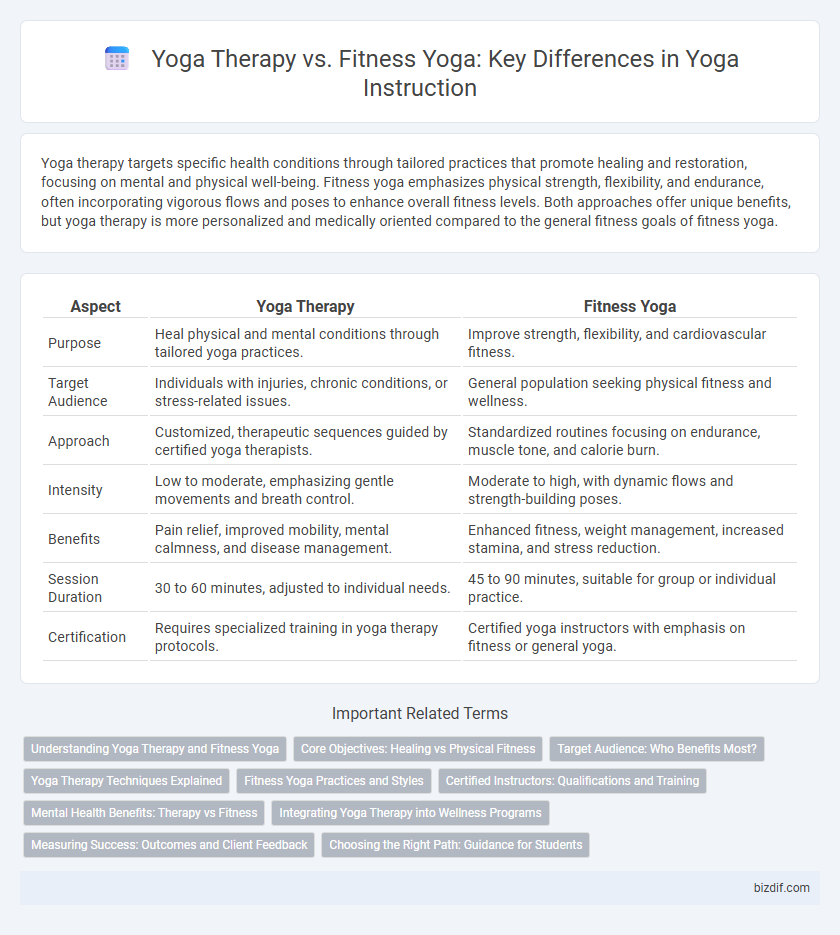Yoga therapy targets specific health conditions through tailored practices that promote healing and restoration, focusing on mental and physical well-being. Fitness yoga emphasizes physical strength, flexibility, and endurance, often incorporating vigorous flows and poses to enhance overall fitness levels. Both approaches offer unique benefits, but yoga therapy is more personalized and medically oriented compared to the general fitness goals of fitness yoga.
Table of Comparison
| Aspect | Yoga Therapy | Fitness Yoga |
|---|---|---|
| Purpose | Heal physical and mental conditions through tailored yoga practices. | Improve strength, flexibility, and cardiovascular fitness. |
| Target Audience | Individuals with injuries, chronic conditions, or stress-related issues. | General population seeking physical fitness and wellness. |
| Approach | Customized, therapeutic sequences guided by certified yoga therapists. | Standardized routines focusing on endurance, muscle tone, and calorie burn. |
| Intensity | Low to moderate, emphasizing gentle movements and breath control. | Moderate to high, with dynamic flows and strength-building poses. |
| Benefits | Pain relief, improved mobility, mental calmness, and disease management. | Enhanced fitness, weight management, increased stamina, and stress reduction. |
| Session Duration | 30 to 60 minutes, adjusted to individual needs. | 45 to 90 minutes, suitable for group or individual practice. |
| Certification | Requires specialized training in yoga therapy protocols. | Certified yoga instructors with emphasis on fitness or general yoga. |
Understanding Yoga Therapy and Fitness Yoga
Yoga therapy targets specific physical, mental, and emotional health issues through personalized practices that promote healing and balance, often guided by certified yoga therapists. Fitness yoga emphasizes improving strength, flexibility, and endurance, focusing on general wellness and physical fitness through dynamic and diverse poses. Understanding these approaches helps individuals choose between therapeutic intervention and overall physical conditioning based on their health goals.
Core Objectives: Healing vs Physical Fitness
Yoga therapy centers on personalized practices designed to address specific health conditions and promote holistic healing by balancing the body, mind, and spirit through targeted poses and breathwork. Fitness yoga emphasizes strength, flexibility, and cardiovascular health, aiming to enhance overall physical performance and endurance with dynamic sequences and vigorous postures. Healing in yoga therapy involves rehabilitating the nervous system and reducing stress, while fitness yoga prioritizes muscle toning and stamina building for optimal physical fitness.
Target Audience: Who Benefits Most?
Yoga therapy specifically targets individuals with chronic health conditions, injuries, or mental health challenges, offering personalized interventions to promote healing and symptom management. Fitness yoga appeals primarily to physically active individuals seeking to enhance strength, flexibility, and cardiovascular fitness through dynamic sequences. Understanding these distinctions helps practitioners choose an approach aligned with their health needs and wellness goals.
Yoga Therapy Techniques Explained
Yoga therapy techniques prioritize personalized healing through targeted postures, breath control, and mindfulness, addressing specific physical and mental health conditions. Unlike fitness yoga, which emphasizes strength, flexibility, and cardiovascular benefits, yoga therapy integrates therapeutic tools such as restorative poses, guided meditation, and pranayama practices to promote rehabilitation and stress reduction. These specialized methods are designed to support chronic pain management, anxiety relief, and overall well-being in a clinical or individualized setting.
Fitness Yoga Practices and Styles
Fitness yoga practices such as Vinyasa, Ashtanga, and Power Yoga prioritize physical strength, flexibility, and cardiovascular endurance, emphasizing dynamic sequences and intense postures. These styles often incorporate flowing movements synchronized with breath, enhancing muscular stamina and promoting weight loss. Unlike yoga therapy, which targets healing and rehabilitation, fitness yoga focuses on optimizing athletic performance and overall physical fitness.
Certified Instructors: Qualifications and Training
Certified instructors in yoga therapy undergo extensive training in anatomy, physiology, and mental health to tailor practices for specific medical conditions, contrasting with fitness yoga teachers who primarily focus on physical postures and general wellness. Yoga therapists often hold advanced certifications or licenses, ensuring a deep understanding of therapeutic techniques and contraindications. Fitness yoga instructors typically complete shorter certification programs emphasizing alignment, physical fitness, and flexibility, aimed at enhancing overall physical health and stamina.
Mental Health Benefits: Therapy vs Fitness
Yoga therapy emphasizes personalized practices targeting mental health conditions such as anxiety, depression, and PTSD, often integrating mindfulness and breathwork to promote emotional regulation and stress reduction. Fitness yoga primarily focuses on physical strength, flexibility, and endurance, offering general mental benefits like improved mood and stress relief but lacking the targeted therapeutic approach. Research shows yoga therapy's tailored interventions can significantly reduce symptoms of mental health disorders, making it a complementary treatment alongside conventional mental health care.
Integrating Yoga Therapy into Wellness Programs
Yoga therapy emphasizes individualized healing by addressing specific physical and mental health conditions through tailored practices, making it a vital component in comprehensive wellness programs. Integrating yoga therapy into wellness initiatives enhances overall health outcomes by combining therapeutic techniques with general fitness routines. This fusion supports injury prevention, stress reduction, and improved chronic condition management within holistic health strategies.
Measuring Success: Outcomes and Client Feedback
Success in yoga therapy is measured by improvements in clients' physical and mental health, such as reduced pain, increased mobility, and decreased stress levels, often tracked through clinical assessments and personalized progress reports. Fitness yoga success focuses on enhanced strength, flexibility, and endurance, with measurable outcomes like increased workout intensity, calorie burn, and client satisfaction ratings. Client feedback in yoga therapy emphasizes therapeutic benefits and symptom relief, while fitness yoga feedback highlights performance gains and overall well-being enhancements.
Choosing the Right Path: Guidance for Students
Yoga therapy targets specific health conditions through personalized sessions addressing physical and mental well-being, while fitness yoga emphasizes general strength, flexibility, and endurance improvements. Students should assess their individual needs, such as managing chronic pain or enhancing athletic performance, to select the appropriate yoga path. Consulting certified instructors specialized in therapeutic or fitness yoga ensures a tailored approach for optimal benefits.
Yoga therapy vs Fitness yoga Infographic

 bizdif.com
bizdif.com